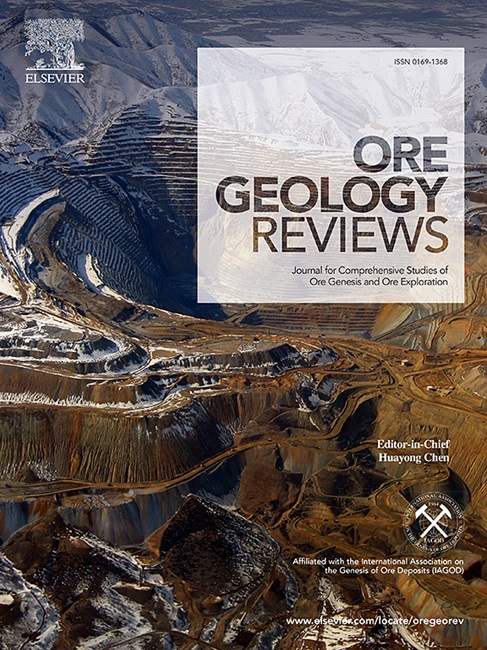Metallogeny of celestite deposits in Iran; implications for future explorations
IF 3.6
2区 地球科学
Q1 GEOLOGY
引用次数: 0
Abstract
In Iran, celestite deposits/occurrences are found in two structural zones of the (1) Central Iran zone, and (2) Zagros Folded Thrust Belt. The host rock age of the celestite deposits in the world varies from Silurian to Pliocene but in Iran this mineralization’s are specific to the Neogene carbonate-evaporite sequences, which is the (1) Oligo-Miocene Qom Formation in Central Iran zone; (2) the Oligo-Miocene Asmari Formation; and (3) the Early-Middle Miocene Gachsaran-Mishan Formations in the Zagros Folded Thrust Belt, which is known as the youngest host of celestite mineralization in Iran. The marl-carbonate members of the Oligo-Miocene Qom Formation in Central Iran zone hosts the most significant and largest celestite deposits, such as Arvaneh-Aftar, Davazdah-Emam, Siah-Kuh, Madabad, Mazraeh, Nakhjir-Kuh, Kuh-Talhe, Abardej, Kazemabad, Qaleh-Boland, Deh-Namak, Baztab, Paiiez, Pis-Kuh in Jandag area, Tapeh-Gobar, Khoushab-Rood, Zand-e-Fashafoieh, Maranjab, Gand-Aab, Huk, and Makresh deposits. Molkabad deposit in the Central Iran zone, with a reserve of 2Mt, which are typically associated with shallow marine environments is the largest and most important celestite deposit in Iran and also one of the largest celestite deposits in the world. In the Zagros Folded Thrust Belt, the most important celestite deposits located in the Asmari carbonatic Formation in the Bangestan anticline which including Tang-Ban, Tang-e-Nayab, Gonbad-Bardi, Kal-Ahmadi, Posht-Par, Dopar-Nazari, Tortab, Tarak, Gudben, Abolfares, Mokhdan, Konj-e-Konj, Takhtan, Hormuz, Doghonbadan, Abdanan, Pirmored, and Dasht-e-Ahoo deposits. The well-known deposits of Gachsaran-Mishan Formations are the Likak, and Baba-Mohammad deposits. It seems that the evaporite lithology of the Gachsaran Formation can be a suitable environment for celestite mineralization in the Zagros Folded Thrust Belt. According to the Cenozoic celestite mineralization in Iran, it can be concluded the Neo-Tethys oceanic cycle and the geodynamic evolution of the related sedimentary basins played a role in the formation of these deposits. The largest celestite deposits formed during diagenetic replacements and open-space filling processes in coastal carbonate- evaporite sequences. Shallow epicontinental basins are the main geological environment for celestite deposits. Qom back-arc environment and Zagros foreland basin are the main depositional environments for celestite mineralization’s. Saline Sr-rich fluids, shallow depositional environment, regression of sea water, karst-dolomitization process, and semi-arid climate are among the most important factors controlling Iranian celestite deposits. Understanding of the temporal-spatial distribution of celestite deposits in Iran provides valuable insights for exploration and exploitation efforts.

伊朗天青石矿床的成矿作用对未来探索的启示
在伊朗,天青石矿床分布于(1)伊朗中部构造带和(2)扎格罗斯褶皱冲断带两个构造带。世界上天青石矿床的寄主岩年龄从志留系到上新世不等,但在伊朗,这种成矿作用是针对新近系碳酸盐岩-蒸发岩序列的,即(1)伊朗中部地区渐近-中新世库姆组;(2)渐新世-中新世Asmari组;(3) Zagros褶皱冲断带早中新世-中中新世Gachsaran-Mishan组,被认为是伊朗最年轻的天青石成矿主体。伊朗中部地区oligo -中新世Qom组泥灰岩段拥有最重要和最大的天青石矿床,如Arvaneh-Aftar、Davazdah-Emam、Siah-Kuh、Madabad、Mazraeh、Nakhjir-Kuh、Kuh-Talhe、Abardej、Kazemabad、Qaleh-Boland、Deh-Namak、Baztab、Paiiez、Pis-Kuh在Jandag地区、tech - gobar、Khoushab-Rood、Zand-e-Fashafoieh、Maranjab、Gand-Aab、Huk和Makresh矿床。Molkabad矿床位于伊朗中部地区,储量为200万吨,通常与浅海环境有关,是伊朗最大和最重要的天青石矿床,也是世界上最大的天青石矿床之一。在扎格罗斯褶皱冲断带,最重要的天青石矿床位于孟加拉国背斜的Asmari碳酸盐岩组,包括Tang-Ban、Tang-e-Nayab、Gonbad-Bardi、Kal-Ahmadi、Posht-Par、Dopar-Nazari、Tortab、Tarak、Gudben、Abolfares、Mokhdan、Konj-e-Konj、Takhtan、Hormuz、Doghonbadan、Abdanan、pir移动和Dasht-e-Ahoo矿床。Gachsaran-Mishan组的著名矿床是Likak和Baba-Mohammad矿床。认为扎格罗斯褶皱冲断带Gachsaran组的蒸发岩岩性可能是天青石成矿的适宜环境。根据伊朗新生代天青石的成矿作用,可以认为新特提斯海洋旋回和相关沉积盆地的地球动力学演化对这些矿床的形成起了作用。最大的天青石矿床形成于海岸碳酸盐岩-蒸发岩层序的成岩置换和开放空间充填过程。浅陆表盆地是天青石矿床的主要地质环境。库姆弧后环境和扎格罗斯前陆盆地是天青石成矿的主要沉积环境。含盐富锶流体、浅层沉积环境、海水回归、岩溶白云化过程和半干旱气候是控制伊朗天青石矿床的重要因素。了解伊朗天青石矿床的时空分布为勘探和开采工作提供了有价值的见解。
本文章由计算机程序翻译,如有差异,请以英文原文为准。
求助全文
约1分钟内获得全文
求助全文
来源期刊

Ore Geology Reviews
地学-地质学
CiteScore
6.50
自引率
27.30%
发文量
546
审稿时长
22.9 weeks
期刊介绍:
Ore Geology Reviews aims to familiarize all earth scientists with recent advances in a number of interconnected disciplines related to the study of, and search for, ore deposits. The reviews range from brief to longer contributions, but the journal preferentially publishes manuscripts that fill the niche between the commonly shorter journal articles and the comprehensive book coverages, and thus has a special appeal to many authors and readers.
 求助内容:
求助内容: 应助结果提醒方式:
应助结果提醒方式:


